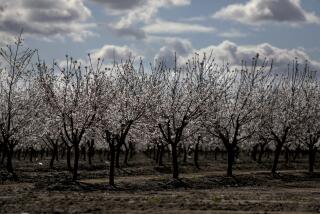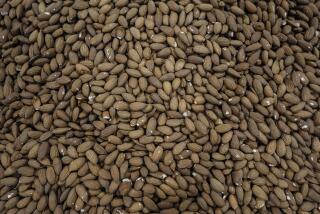Almonds Come in Variety of Forms
- Share via
Question: I would like you to address the subject of almonds--beginning to end.
Answer: The beginning poses a challenge since no one knows exactly where almonds originated or who first cultivated them for use as food. According to information from the Almond Board of California, however, records do show that the nuts were growing in Greece 300 years before the time of Christ.
The Romans introduced almonds to Egypt and some Western European countries; the Moors planted almond trees in Portugal and Spain. New World explorers transported almonds to Mexico, and from there Franciscan Padres brought them to California.
Today California is the only area in North America where almonds are grown commercially. The five major varieties cultivated in a 400-mile stretch from Red Bluff to Bakersfield account for more than half of the world’s supply.
One ounce (20 to 25 nuts) of whole shelled almonds contains 170 calories, six grams protein, five grams carbohydrates, 14 grams fat and four milligrams sodium. The following percentage of USRDA for minerals is also present: 15% phosphorus; 15% copper; 20% magnesium; 8% iron; 8% calcium.
Almonds are sold in a variety of forms:
Whole natural almonds--shells removed, brown skins still present.
Whole blanched almonds--shells and skins removed.
Sliced natural almonds--thinly sliced lengthwise; contain thin band of brown skin.
Sliced blanced almonds--blanched and skins removed; thinly sliced lengthwise.
Blanched slivered almonds--blanched and skins removed; halved, then cut lengthwise in pieces about the thickness of a match stick.
Roasted blanched slivered almonds--blanched and skins removed; slivered and roasted to golden brown.
Chopped natural almonds--brown-skinned almonds that have been coarsely chopped.
Diced roasted salted almonds--finely diced, salted and roasted.
TO BLANCH WHOLE NATURAL ALMONDS:
Cover with boiling water. Let stand three minutes, then test to see if skins slip off easily. Remove almonds from water one at a time, slip off skins and let dry on paper towel several hours.
TO TOAST ALMONDS:
Conventional Oven: Spread almonds in a single layer in a shallow pan. Place in a cold oven and toast at 350 degrees 10 minutes, stirring once or twice. Cool.
Microwave Oven: Spread almonds in a single layer in a shallow glass baking dish. Microwave on HIGH (100% power) four to five minutes, stirring halfway through. Cool.
Skillet: Spread almonds in a single layer in large skillet over medium heat. Cook about 12 to 14 minutes, stirring constantly.
TO CHOP ALMONDS:
Food Processor or Blender: Place in food processor or blender and process continuously until chopped.
Knife: Warm almonds slightly before chopping to reduce shattering.
TO GRIND ALMONDS:
Food Processor or Blender: Place in food processor or blender and process continuously until ground.
One cup sliced almonds equals 3 1/4 ounces
One cup slivered almonds equals 4 1/2 ounces
One cup whole almonds (shelled) equals five ounces and will yield approximately 1 1/4 cups when ground in a blender or food processor.
Almonds stored in tightly sealed containers in a cool dry place, such as the refrigerator, will stay fresh for months. They may be frozen for even longer periods.
More to Read
Eat your way across L.A.
Get our weekly Tasting Notes newsletter for reviews, news and more.
You may occasionally receive promotional content from the Los Angeles Times.








